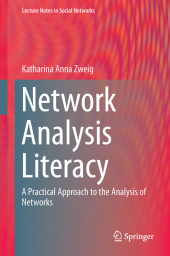 Neuerscheinungen 2016Stand: 2020-02-01 |
Schnellsuche
ISBN/Stichwort/Autor
|
Herderstraße 10
10625 Berlin
Tel.: 030 315 714 16
Fax 030 315 714 14
info@buchspektrum.de |

Katharina Anna Zweig
Network Analysis Literacy
A Practical Approach to the Analysis of Networks
1st ed. 2016. xxiii, 535 S. 112 SW-Abb., 14 Farbabb., 14 Farbtabellen. 241 mm
Verlag/Jahr: SPRINGER, WIEN 2016
ISBN: 3-7091-0740-7 (3709107407)
Neue ISBN: 978-3-7091-0740-9 (9783709107409)
Preis und Lieferzeit: Bitte klicken
Network Analysis Literacy focuses on design principles for network analytics projects. The text enables readers to: pose a defined network analytic question; build a network to answer the question; choose or design the right network analytic methods for a particular purpose, and more.
This book presents a perspective of network analysis as a tool to find and quantify significant structures in the interaction patterns between different types of entities. Moreover, network analysis provides the basic means to relate these structures to properties of the entities. It has proven itself to be useful for the analysis of biological and social networks, but also for networks describing complex systems in economy, psychology, geography, and various other fields. Today, network analysis packages in the open-source platform R and other open-source software projects enable scientists from all fields to quickly apply network analytic methods to their data sets. Altogether, these applications offer such a wealth of network analytic methods that it can be overwhelming for someone just entering this field. This book provides a road map through this jungle of network analytic methods, offers advice on how to pick the best method for a given network analytic project, and how to avoid common pitfalls. It introduces the methods which are most often used to analyze complex networks, e.g., different global network measures, types of random graph models, centrality indices, and networks motifs. In addition to introducing these methods, the central focus is on network analysis literacy - the competence to decide when to use which of these methods for which type of question. Furthermore, the book intends to increase the reader´s competence to read original literature on network analysis by providing a glossary and intensive translation of formal notation and mathematical symbols in everyday speech. Different aspects of network analysis literacy - understanding formal definitions, programming tasks, or the analysis of structural measures and their interpretation - are deepened in various exercises with provided solutions. This text is an excellent, if not the best starting point for all scientists who want to harness the power of network analysis for their field of expertise.
Dedication.- Preface.- Part I Introduction.- A First Encounter.- Graph Theory, Social Network Analysis, and Network Science.- Definitions.- Part II Methods.- Classic Network Analytic Measures.- Network Representations of Complex Systems.- Random Graphs and Network Models.- Random Graphs as Null Models.- Understanding and Designing Network Measures.- Centrality Indices.- Part III Literacy.- Literacy: Data Quality, Entities and Nodes.- Literacy: Relationships and Relations.- Literacy: When is a Network Model Explanatory?.- Literacy: Choosing the Best Null Model.- Literacy Interpretation.- Ethics in Network Analysis.- Appendix A - The structure and typical outlets of network analytic papers.- Appendix B - Glossary.- Appendix C - Solutions to the Problems.- Name Index.- Subject Index.


